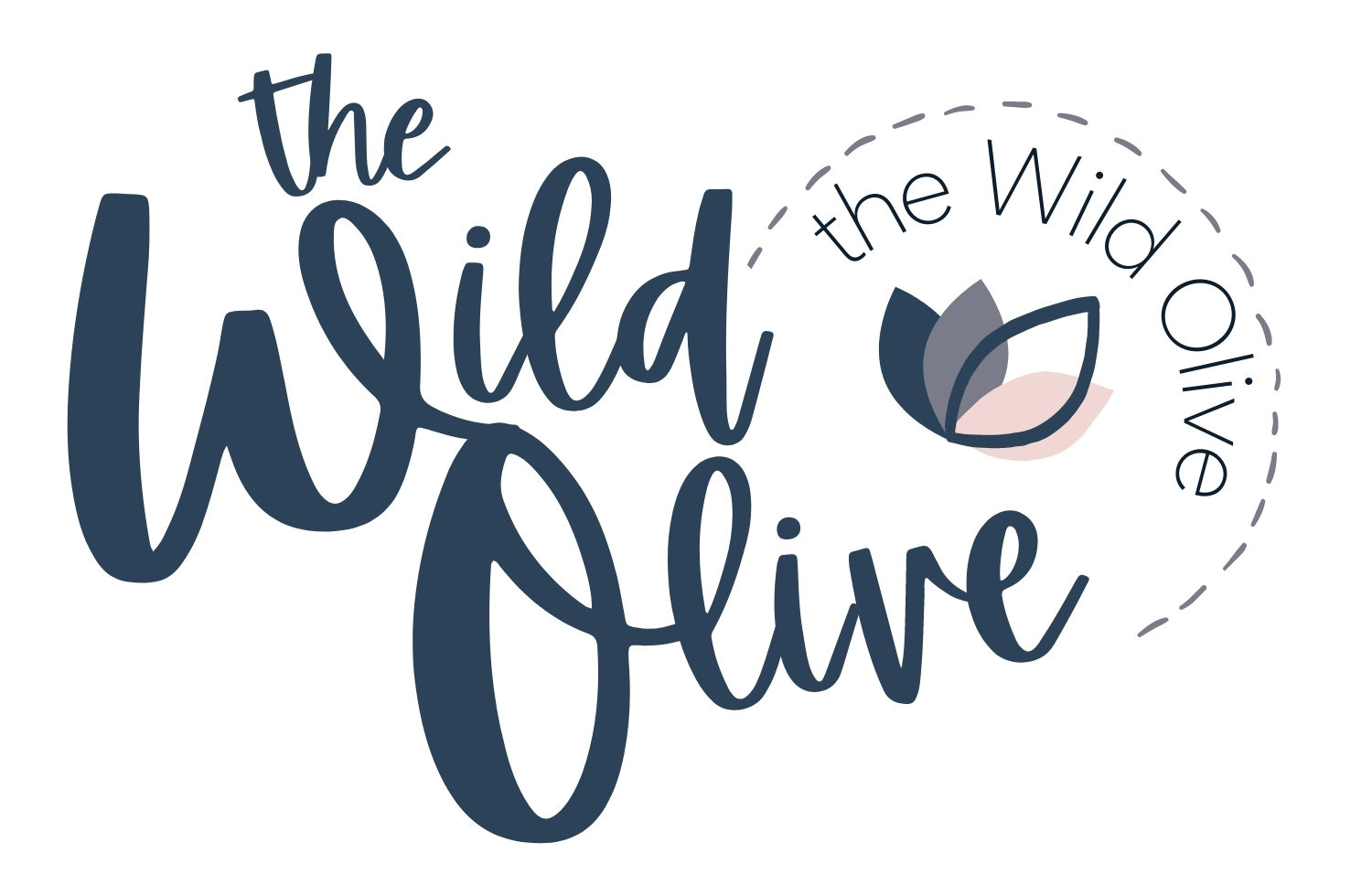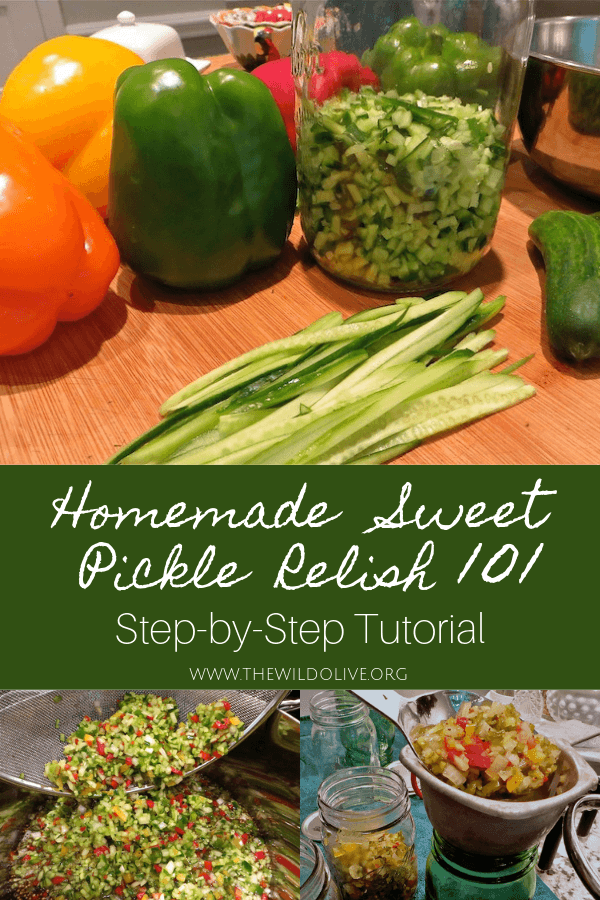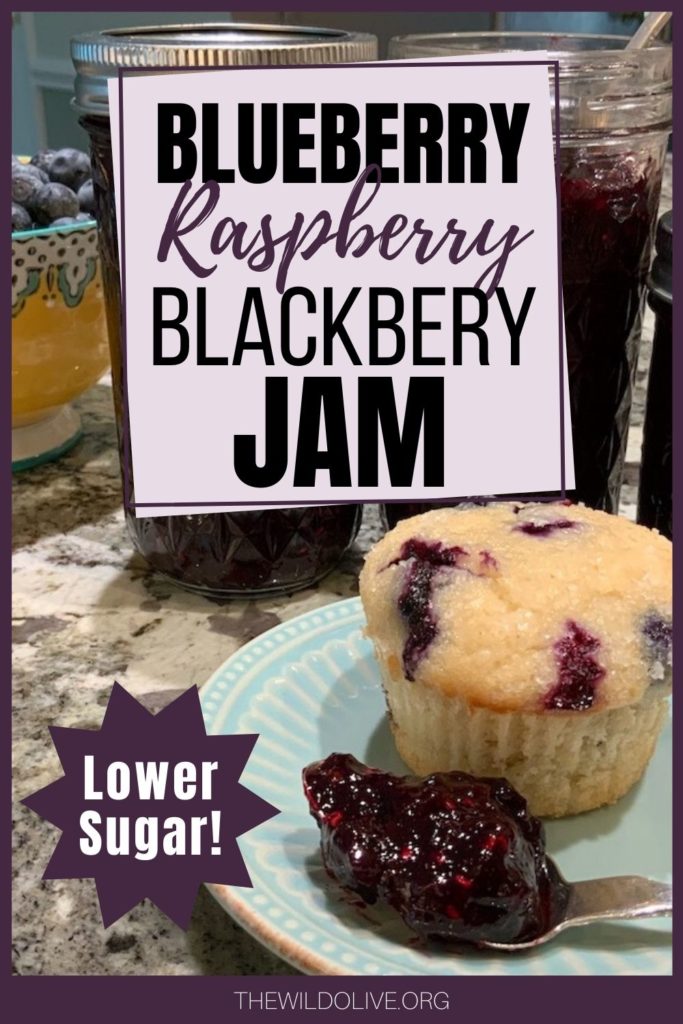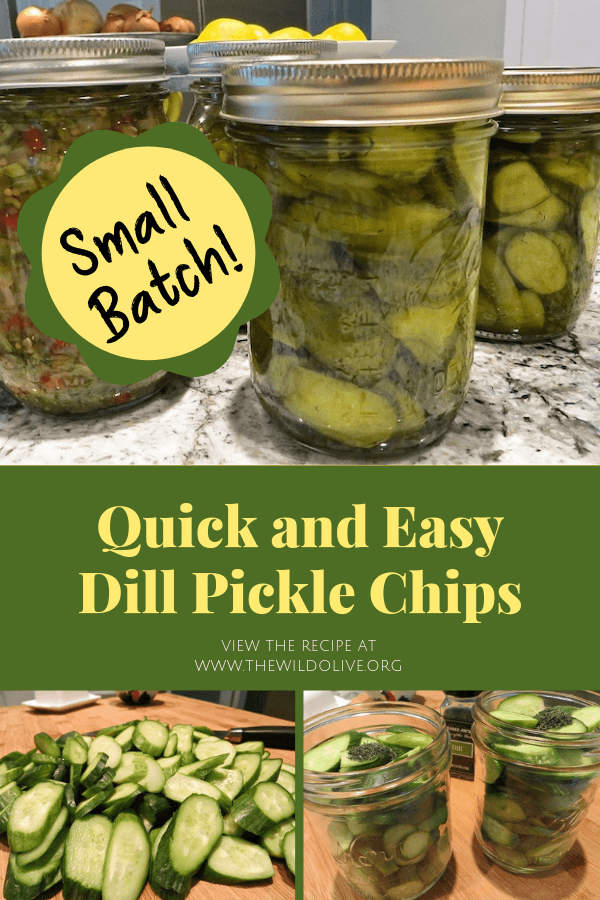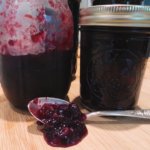Blueberry-Grape Jam Made with Thomcord Grapes
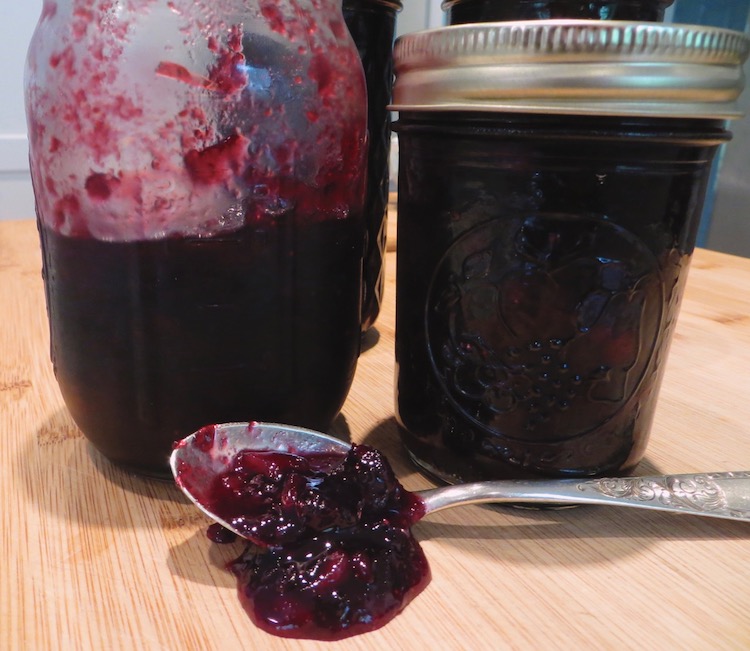
Blueberries are one of the only summer fruits that are more delicious when they are cooked rather than fresh. And they are gloriously so in this Blueberry-Grape Jam starring fresh (or frozen!) blueberries and Thomcord Grapes.
About 10 years ago my husband planted 5 blueberry bushes, and every summer they present us with many quarts of plump, delicious berries which I carefully pack and freeze. That is, after we eat so many of them fresh that I start to feel like a bear fattening up for the winter. Because of our annual bounty I have come up with numerous salads, breads, desserts and jams to put all those berries to good use.
Thomcord Grapes – the Secret to Easy Blueberry-Grape Jam
Blueberry-Blackberry jam was a favorite use for many summers until I discovered something called Thomcord Grapes. Have you tried these amazing little balls of flavor? Swoon! They are a cross between Concord and Thompson Seedless Grapes, with the deep, complex flavor of the Concords and the thin skin and minimal seeds of the Thompsons.
I swapped in some Thomcords for the blackberries in my favorite jam and pure magic ensued. The flavor of this jam is very blueberry-forward but with bright grape notes. Not only is my Blueberry-Grape Jam super delicious, but it also uses a fraction of the sugar found in most “modern” jam recipes.
Pin This Recipe for Later!
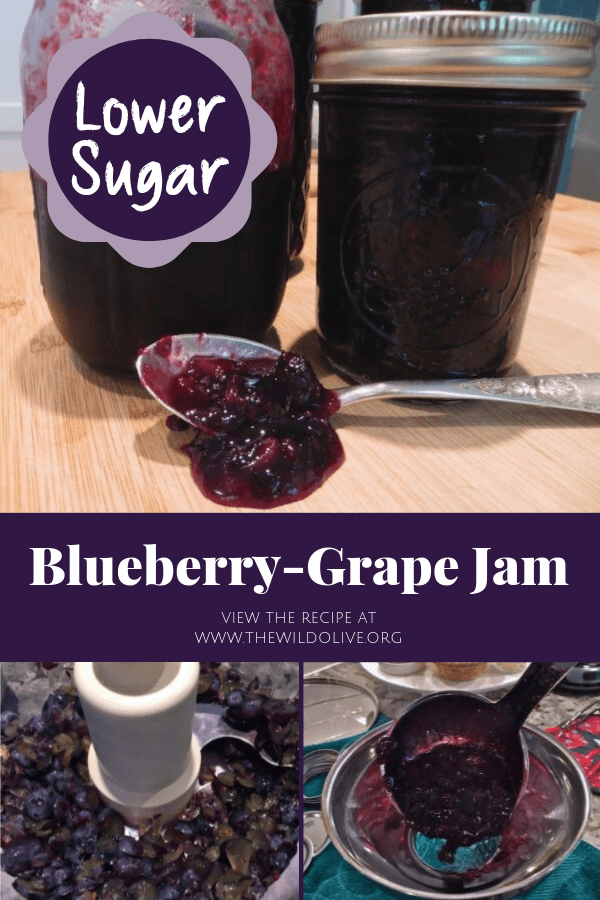
How to Make Jams with Less Sugar
Modern jam recipes rely on powdered pectin and heaps of sugar to set, or gel, the jam. Sure, they are quick to make, but you’re basically putting fruit-flavored sugar on your toast. Meh. Thankfully, many home cooks are returning to making jams the old fashioned way, which relies on the naturally occurring pectin in the fruit, a much smaller amount of sugar, and time.
I’ve made my jams the old way for many years now. Not only are these jams more flavorful (not to mention healthier), but the process to make them is very satisfying and relaxing. I have to say, spending an afternoon putting up preserves is one of my favorite ways to just chill and have some “me” time.
PS – here’s an article on other ways I keep a lid on the amount of sugar I consume while still enjoying the foods I love to make and eat.
What’s Involved with Making Jams the Old Fashioned Way?
All you need to make around 5 half-pints of my Blueberry-Grape Jam is 4 ingredients and some time. Because there is no added pectin, the fruit and sugar mixture has to rest 2 hours to draw out the natural pectin. Time-wise, you’re looking at 10 minutes to prep the fruit mixture, 2 hours for the mixture to macerate (i.e. chillax and let the pectin draw out) and about an hour to cook and process the jam.
Here’s What You Need to Make Blueberry-Grape Jam
- 8 oz Thomcord Grapes, washed and destemmed
- 1 lb 12 oz blueberries, frozen is fine
- 2 cups sugar
- 2 Tbsp. fresh lemon juice or ½ tsp. citric acid
Here’s What to Do
Prep the Fruit
It’s perfectly fine to use frozen blueberries here. Our blueberries are done producing before Thomcords show up in stores, so I always use berries I’ve stashed in the freezer. Just make sure you are using “fresh” frozen berries – not old ones that are freezer burned and covered with ice. If you are using frozen berries like I did, let them thaw a few minutes before proceeding.
Pulse grapes in food processor until coarsely chopped.
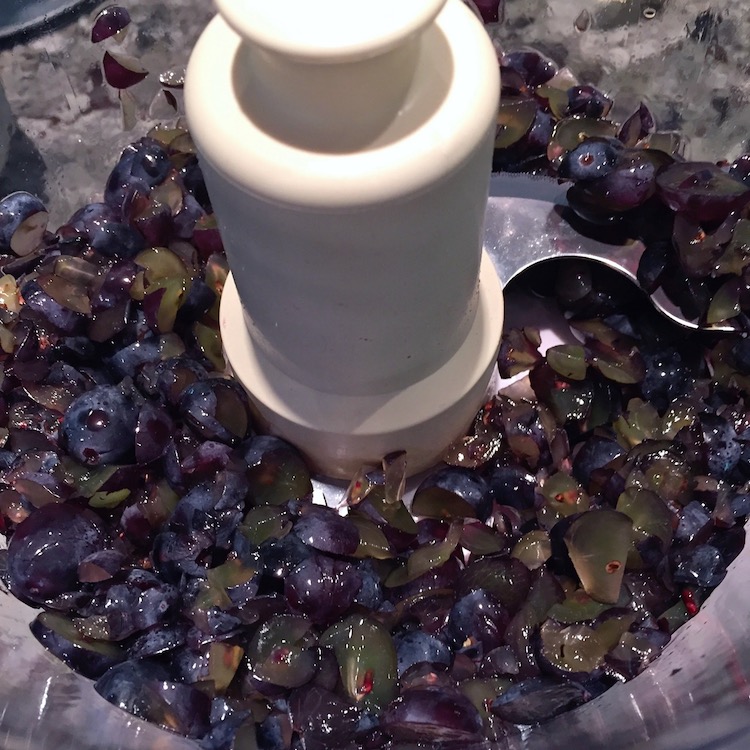
Add HALF the blueberries and pulse a few times, till blueberries are coarsely chopped. Do NOT puree the fruit!
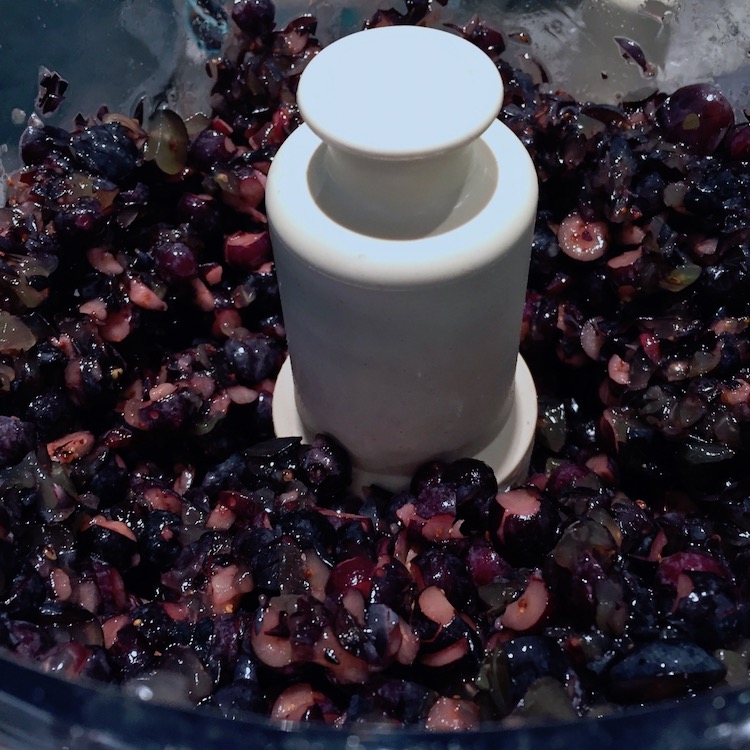
Preparing the Blueberry-Grape Mixture
In a large, wide, heavy, stainless steel pan combine the chopped fruits, the rest of the whole blueberries, sugar and lemon juice (or citric acid). Stir to combine and let the mixture rest 30 minutes – the sugar does not need to dissolve.
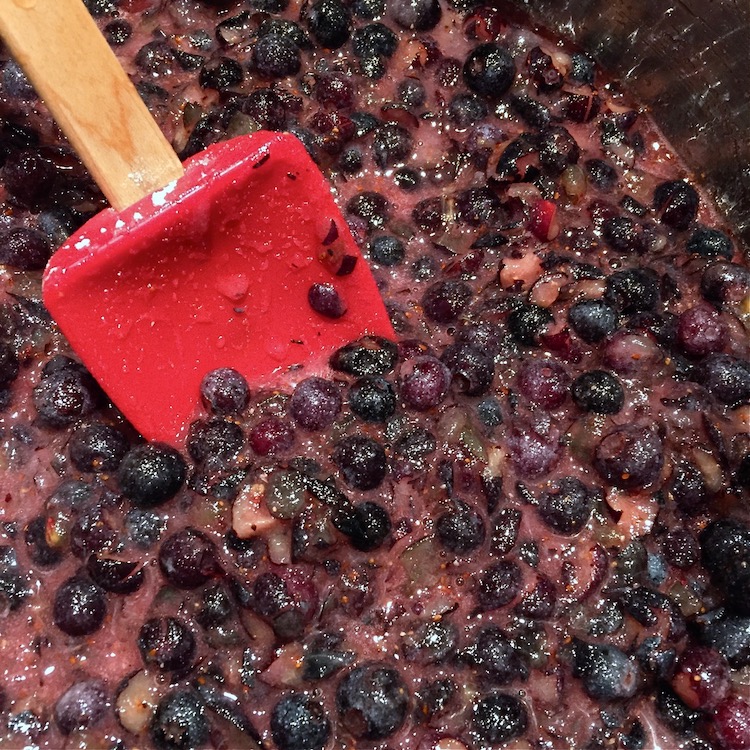
After 30 minutes, gently press fruit mixture with a potato masher till all blueberries are lightly crushed. Stir until sugar fully dissolves. Let the mixture rest another 90 minutes, stirring every 30 minutes. Don’t cheat this rest period or your jam may struggle to set, and you don’t want to go to all this bother to make soupy jam.
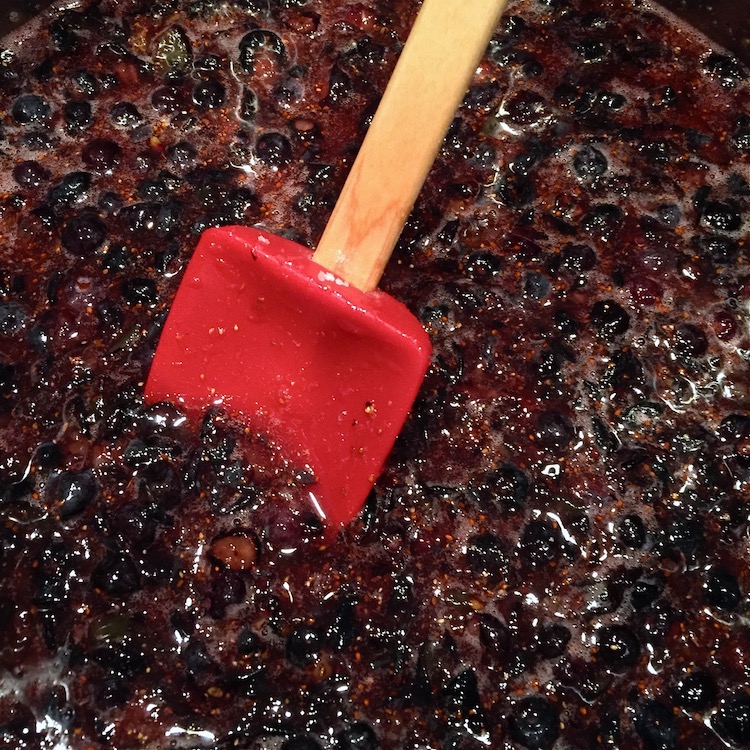
Cooking the Blueberry-Grape Jam
During these two hours, get your hot water bath set up and sterilize your jars and lids. For waaay more information about canning and food safety for homemade preserves, please check out the Ball Canning Co website. It’s an excellent resource for novices and experienced cooks alike!
Place pan with fruit mixture over high heat and bring to a boil while stirring. Once the mixture boils, turn the heat down a bit and stir frequently to prevent scorching and boiling over. The mixture will begin to foam a bit on top as it cooks (see photo). You can skim the foam or just wait for it to subside, which it usually does.
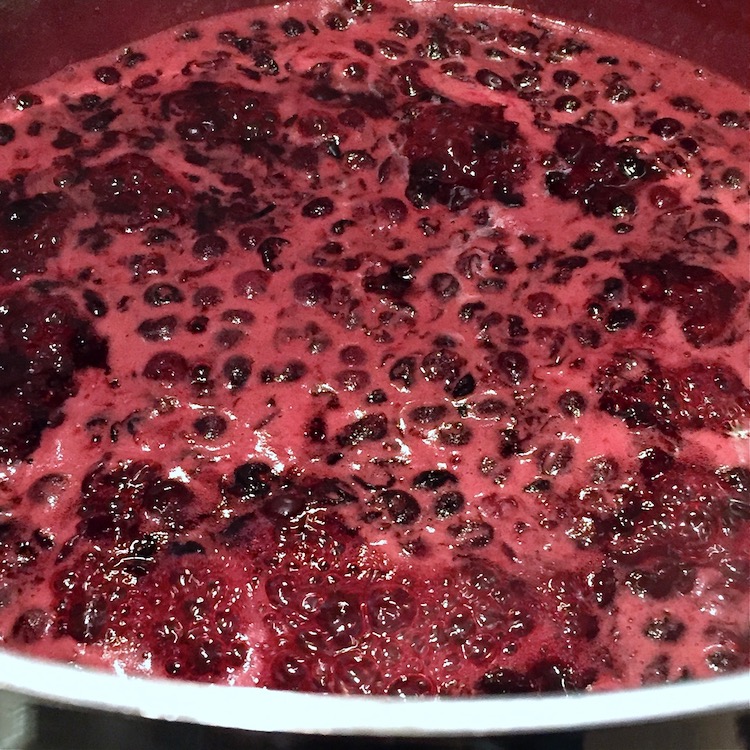
As the mixture cooks and thickens, it will turn a gorgeous deep purple. Cook fruit, scraping the sides and bottom of the pan every minute or so until mixture reaches the gelling point.
What’s the Gelling Point?
The Gelling Point is the point when the sugar in the jam/jelly reaches a temp where it will “set” your product. If you’ve ever made fudge or other candies, you are familiar with this concept – getting sugar to a specific temperature for a desired result.
Knowing When Your Jam is Done – Temperature Test
Technically speaking, the gelling point for jam is reached at 8 degrees above the temp at which water boils at your altitude. If you have an accurate instant-read thermometer, simply take the temperature of the rapidly boiling water in the hot water bath you are prepping, and add 8 degrees. You will cook your jam until it reaches that temperature.
Knowing When Your Jam is Done – Plate Test
If you don’t have an accurate instant-read thermometer, you can still make this recipe. One method to test doneness is the “plate test”. Before cooking your jam, place a saucer in the freezer. When the jam begins to thicken, start testing. To test the jam, remove pot from heat and place 1 tsp. jam on plate in freezer; wait 1 minute. Take plate out of freezer and lightly push jam with finger – if the surface “crinkles” it is done. If Jam is runny, continue cooking jam and retest.
Once you’ve made jam a few times, you will be able to tell just by looking at it in the pot if it is done. When I suspect my jam is done, I turn off the heat and wait a minute. As you can see in the photo below, when you take properly cooked jam off the heat and let it cool for a moment, the mixture will “crinkle” on the surface when you drag a spoon across the top.
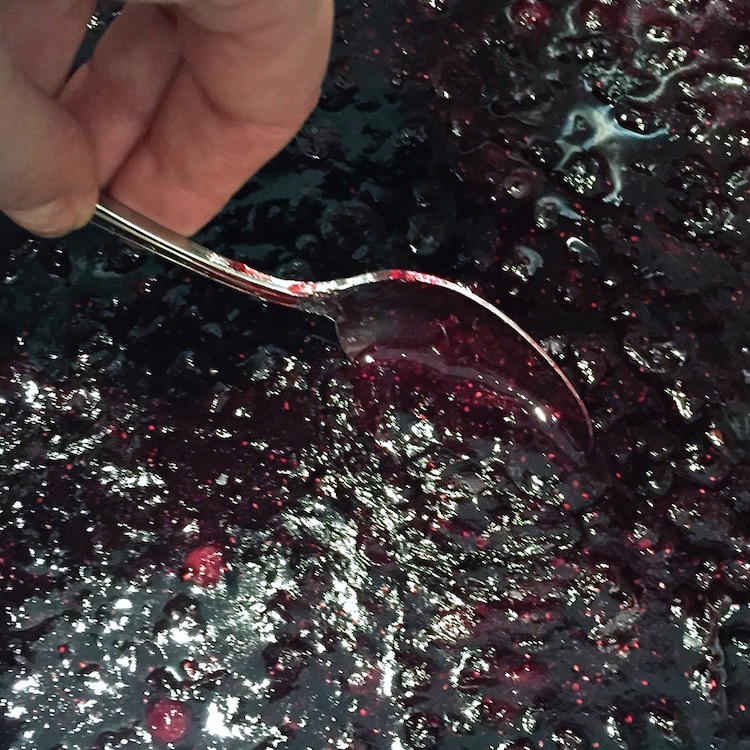
Processing Your Blueberry-Grape Jam
When jam tests done, ladle hot jam into sterilized half-pint (8 oz.) jars, leaving ½” headspace. Using a stainless steel funnel makes this task a snap! You should have at least 4 if not 5 half-pints of jam. If your fifth jar isn’t quite full, do not process it in the boiling water bath. Simply pop on the lid, let the jam cool a bit and put it in the fridge to enjoy first.
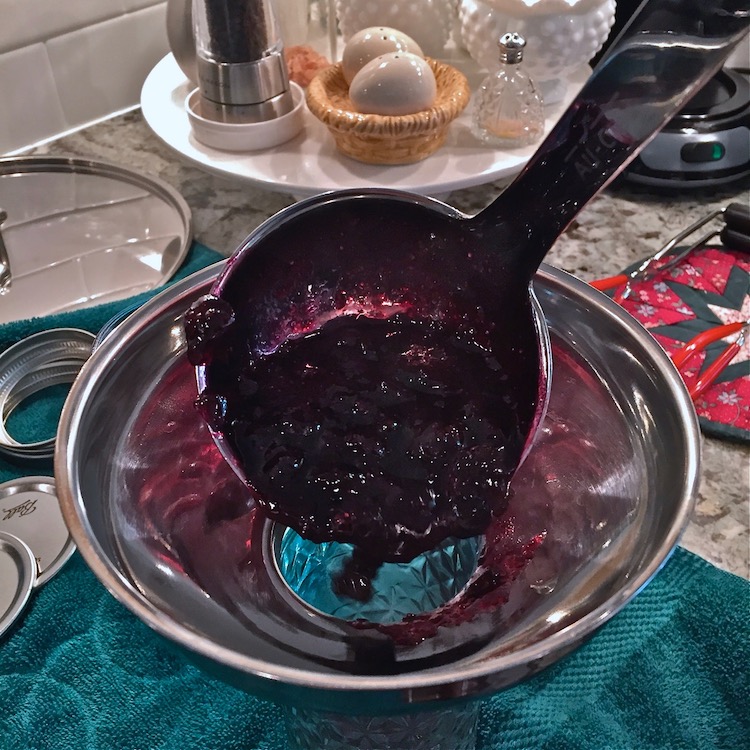
Wipe rims, place new lids on top and seal with bands. Process jars 10 minutes in boiling water bath. Turn off heat, remove lid from canner and allow jars to cool 5 minutes before removing them from water.
Makes around 5 half-pints.
Enjoy!

Here are three other delicious pickles and preserves to try:
Blueberry-Grape Jam
Ingredients
- 8 oz Thomcord Grapes - washed and destemmed
- 1.75 lb (28 oz total) blueberries - frozen is fine
- 2 cups sugar
- 2 Tbsp. fresh lemon juice or ½ tsp. citric acid
Instructions
Prep the Fruit
- If you are using frozen berries let them partially thaw. Pulse grapes in food processor until coarsely chopped. Add HALF the blueberries and pulse a few times, till blueberries are coarsely chopped. Do NOT puree the fruit!
Preparing the Jam Mixture
- In a large, wide, heavy, stainless steel pan combine the chopped fruits, the rest of the whole blueberries, sugar and lemon juice (or citric acid). Stir to combine and let the mixture rest 30 minutes – the sugar does not need to dissolve.
- After 30 minutes, gently press fruit mixture with a potato masher till all blueberries are lightly crushed. Stir until sugar fully dissolves. Let the mixture rest another 90 minutes, stirring every 30 minutes. Don’t cheat this rest period or your jam may struggle to set, and you don’t want to go to all this bother to make soupy jam.
Cooking the Jam
- During these two hours, get your hot water bath set up and sterilize your jars and lids.
- Place pan with fruit mixture over high heat and bring to a boil while stirring. Once the mixture boils, turn the heat down a bit and stir frequently to prevent scorching and boiling over. The mixture will begin to foam a bit on top as it cooks. You can skim the foam or just wait for it to subside, which it usually does.
- As the mixture cooks and thickens, it will turn a gorgeous deep purple. Cook fruit, scraping the sides and bottom of the pan every minute or so until mixture reaches the gelling point.
Knowing When Your Jam is Done – Temperature Test
- Technically speaking, the gelling point for jam is reached at 8 degrees above the temp at which water boils at your altitude. If you have an accurate instant-read thermometer, simply take the temperature of the rapidly boiling water in the hot water bath you are prepping, and add 8 degrees. You will cook your jam until it reaches that temperature.
Knowing When Your Jam is Done – Plate Test
- If you don’t have an accurate instant-read thermometer, you can still make this recipe. One method to test doneness is the “plate test”. Before cooking your jam, place a saucer in the freezer. When the jam begins to thicken, start testing. To test the jam, remove pot from heat and place 1 tsp. jam on plate in freezer; wait 1 minute. Take plate out of freezer and lightly push jam with finger – if the surface “crinkles” it is done. If Jam is runny, continue cooking jam and retest.
- Once you’ve made jam a few times, you will be able to tell just by looking at it in the pot if it is done. When you take properly cooked jam off the heat and let it cool for a moment, the mixture will “crinkle” on the surface when you drag a spoon across the top.
Processing the Jam
- When jam tests done, ladle hot jam into sterilized half-pint (8 oz.) jars, leaving ½” headspace. Using a stainless steel funnel makes this task a snap! You should have at least 4 if not 5 half-pints of jam. If your fifth jar isn’t quite full, do not process it in the boiling water bath. Simply pop on the lid, let the jam cool a bit and put it in the fridge to enjoy first.
